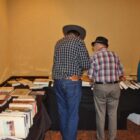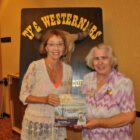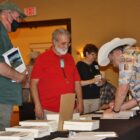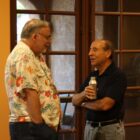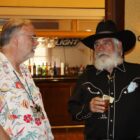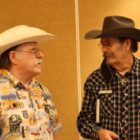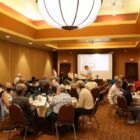Roundup: September 2021
WHOOPI-TY-AYE-OH No. 2
BACK IN THE SADDLE AGAIN
September Roundup
Wednesday, September 8, 2021
Almansor Court – 700 S. Almansor, Alhambra, CA.
Social Hour: 5:00 PM
Dinner: 6:00 PM
Our Speaker: Dr. Geraldine Knatz
Her Subject: The Port of Los Angeles
In one of dozens of classic lines from Chinatown, John Huston’s Noah Cross says to Jack Nicholson’s Jake Gittes that Hollis Mulwray made this city, adding that he also made Cross rich in the process. Theirs was a freshwater empire, made of a complex recipe: greed mixed with altruism, adding hydrology, intrigue, and murder.
Geraldine Knatz insists that what we might call the Los Angeles saltwater story, the Los Angeles Harbor story, is every bit as compelling, mysterious, dramatic, important. She insists that the Port of Los Angeles deserves to have its own tales narrated. And she is right.
The Port of Los Angeles made this city. Its history explodes the intimacy of a case study. It is far more important than that. It very well might be the study of what made modern Los Angeles.
Personalities, crimes, power moves disguised as bureaucratic banalities, jurisdictional feuds, and outright warfare—it is all here. So, too, is the way that the port has remained umbilical to Los Angeles: feeding it, for sure, but also tethering it to worlds an ocean away.”
Roundup Synopsis
Taken From Branding Iron 304 Fall 2021.
The guest speaker for the September Roundup was Geraldine Knatz, speaking about the early 20th-century history of the Port of Los Angeles, centered around her recent 2019 book, Port of Los Angeles: Conflict, Commerce, and the Fight for Control.
Thomas Gibbon in 1891 attempted to build a wharf on Rattlesnake Island (now Terminal island), on tidelands held by individuals erroneously sold by the state. His case was successful, but no action occurred until he was appointed to the Board of Harbor Commissioners in 1907, when he then pushed for the state to recover the property. An agreement was reached in 1917 for the property owners to turn the land over to the city in 30 years. This land would eventually become the Port of Los Angeles. Wilmington and San Pedro would eventually be consolidated with Los Angeles, with the tidelands being transferred to the city. Mormon Island, belonging to the Banning family, was also absorbed by the city in the 1930s after a long legal battle. Thomas Gibbon also attempted to have a railroad built, but this never saw the light of day.
In the 1920s Walter B. Allen was appointed to the Board of Harbor Commissioners, and was seen as someone who could clean up the corruption, though he had his own conflicts of interest in trucking port cargo with his own delivery company. Allen was tasked by the city mayor to merge the ports of Los Angeles and Long Beach. Politics, rate wars, duplicate facilities, and Los Angeles’ desire to control Long Beach’s oil money triggered many attempts to merge the two ports, but they remained separate. Allen was eventually removed due to bad publicity for his involvement with the Julian Petroleum scandal. Many years later Assemblyman Vincent Thomas would also attempt to merge the two ports and was similarly unsuccessful.
WWII forever changed the world’s appreciation of the port. Los Angeles proved that it could move more than just oil, and could be a general cargo port as well. Meanwhile the port customer base was shifting from locally based oil companies to international shipping companies. By the 1960s, trade through Los Angeles Harbor had grown faster than its terminal facilities, longshore workforce, and its own office space could handle. The 1960s for the harbor also saw exciting developments, as if ripped straight from the latest film noir: corruption, graft, secretly taped meetings, indictments, a suspicious death, and a Pulitzer Prize-winning exposé by the Los Angeles Times.
The Port of Long Beach would grow so rapidly that the Los Angeles Board of Harbor Commissioners voted to support merging of the two ports. We continue to hear past and present arguments supporting this initiative, but the ports of Los Angeles and Long Beach remain separate to this day
— Patrick Mulvey


